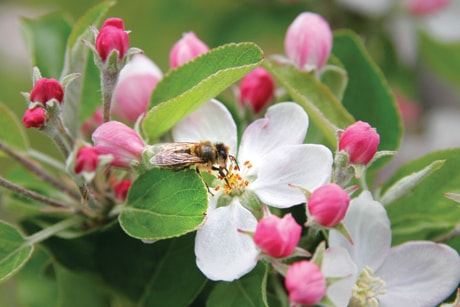Walk through any natural or marginal area in Alberta and you will run into berries. Animals, birds, aboriginals and the early settlers depended on the berries for food.
Horticulturalists have taken the best of the wild selections to develop fruit that is consistently larger, tastier and disease resistant.
Likewise they have introduced fruiting trees such as apples and crab apples have evolved with their fruit being larger, sweeter and a better quality than older varieties.
The end results are the plants that produce the fruit we find in Farmers Markets or at U-picks. The same varieties of plants are available for purchase at garden centers.
Look for plants that are a named ariety as opposed to just the fruit name. Once plants become established, they will provide fruit for years.
Each variety of plant will have different requirements that must be met for the plant to reach full fruiting potential.
One important consideration relates to pollination. In theory, bees will travel over an area of three km pollinating plants. That is a large area so it is best if pollinating plants are closer together.
Planting a pollinator is not as important in an urban setting as there is a good chance that a neighbor has a similar plant. If pollinators are in place and the fruit is still not setting try planting a mass of spring flowering bulbs or early flowering plants. Bees and other insects that are lured into the yard will help pollinate the fruiting plants.
Do some research into the plant’s pollination needs before making a purchase to know what plants are needed.
Evans Cherries are self pollinating but other shrub cherries need a different variety of cherry flowering at the same time to maximize fruit production. Grapes also do their best when there are two different varieties in close proximity.
Nanking Cherries produce more fruit if more than one plant is present. Nankings are one of the best pollinators as they can pollinate some varieties of Plums and Apricots as well as Nanking Cherries. Two apples or crabs are needed to produce fruit. Plants must be blooming at the same time to work as pollinators.
This became a problem this spring when the weather was cold and erratic which in turn caused plants to bloom erratically. It was common to see one branch of the apple tree bloom one week and the other side bloom the next week.
To make matters worse there was a late frost that stops pollination. Expect the apple and crabapple population to be sporadic this fall.
Trees that were in bloom during the frost will not produce fruit this season but should have a huge crop next year. By now, flowers that were not pollinated should have fallen off the plant leaving immature pollinated fruit.
If a large amount of immature fruit is on an apple tree remove the smaller ones until the fruit is about a hands width apart at maturity. Less fruit will mean larger, better developed fruit as opposed to many small ones. Take care not to damage the fruiting wood when removing excess fruit.
Fruit in the wild is large and juicy in wet years. Making sure that the domestic fruiting plants have an adequate and consistent supply of moisture will also improve the quantity and quality of fruit.
Now is a good time to examine fruiting plants to make sure they are healthy and full of fruit.
Linda Tomlinson is a horticulturalist and educator living in Rocky Mountain House. You can contact her at your_garden@hotmail.com.
